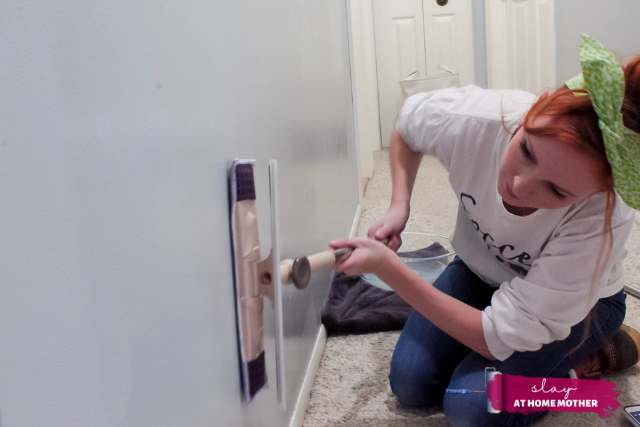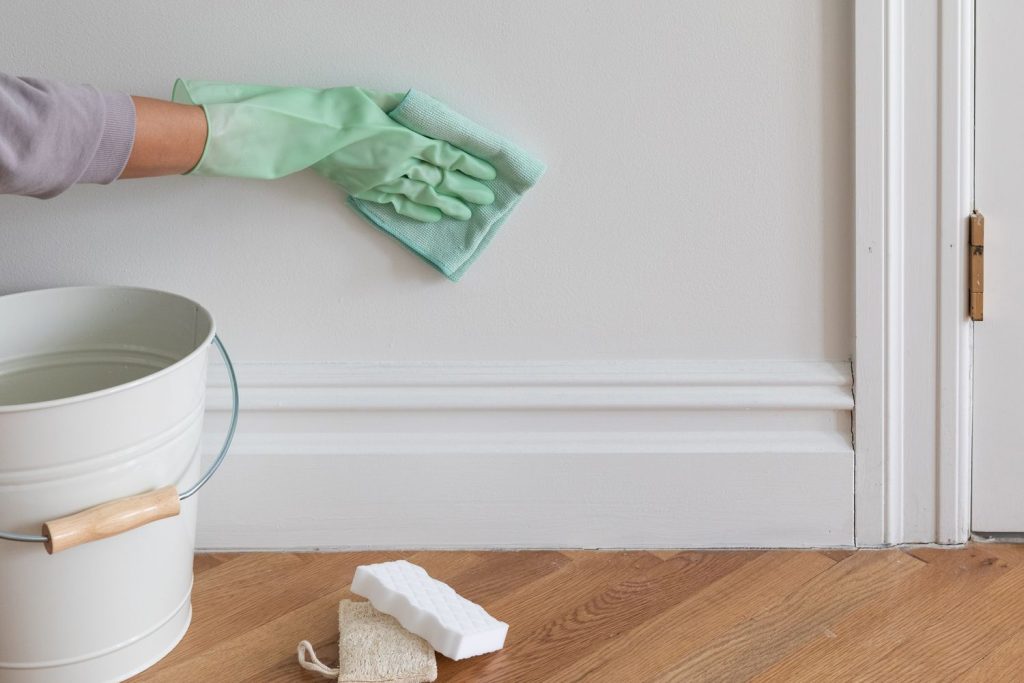For washing walls, a diluted solution of mild dish soap in water works effectively. Always test a small area before a full cleanse to avoid damage.
Preparing to refresh your living space? Washing your walls can transform the ambiance of your home. Over time, dust, grime, and fingerprints accumulate, dulling the lifeliness of your walls. Start by choosing the right cleaner: a mix of warm water and mild dish soap usually does the trick for most painted walls.
It’s gentle enough to avoid stripping paint but strong enough to tackle the dirt. Make sure to wring out the sponge or cloth to prevent water from trickling down and damaging the paint. Tackling this task can be surprisingly rewarding, as clean walls brighten up rooms and create a more inviting atmosphere. Prioritizing the cleanliness of wall surfaces can increase the longevity of your paint job, making this a strategic step in maintaining your home’s interior.
Introduction To Wall Cleaning
Cleaning walls is a key step in maintaining a fresh home environment. Dirt, dust, and fingerprints can make walls look dull. Keeping them clean brightens rooms. It also improves indoor air quality. Knowing the right cleaner for your wall type is important. Different paints and wallpaper need special care. This guide helps you choose the right wall cleaner.
The Importance Of Keeping Walls Clean
Regular wall cleaning can:
- Prevent long-term damage
- Remove allergens and bacteria
- Refresh your home’s appearance
- Extend the life of paint and wallpaper
Factors To Consider Before Choosing A Wall Cleaner
Selecting the best wall cleaner requires thought. Think about:
| Factor | Details to Consider |
|---|---|
| Paint Type | Glossy, satin, or matte affects cleaner choice. |
| Wallpaper | Some are washable, others not. Always check first. |
| Stain Type | Grease needs a different cleaner than crayons. |
| Sensitivity | People with allergies may need a hypoallergenic cleaner. |
Assessing these factors ensures safe and effective wall cleaning.

Credit: www.slayathomemother.com
Types Of Wall Cleaners
When deciding to give your walls a fresh look, the choice of cleaner is key. Various options are available, catering to different types of surfaces and cleaning needs. Understanding the types of wall cleaners can help achieve sparkling results without damaging your walls.
Commercial Wall Cleaners: Pros And Cons
Commercial wall cleaners come ready to use. Brands promise effectiveness and convenience. Here are some benefits and drawbacks:
- Pros:
- Powerful against dirt
- Time-saving
- Specialized formulas
- Cons:
- May contain harsh chemicals
- Can be pricey
- Potential for allergic reactions
Homemade Wall Cleaners: Recipes And Benefits
For those who prefer a DIY approach, homemade wall cleaners are a go-to. Here’s how to make them and their advantages:
- Vinegar Solution: Mix equal parts water and white vinegar.
- Baking Soda Paste: Combine baking soda with a small amount of water.
Benefits include:
- Cost-effective
- Non-toxic ingredients
- Gentle on most surfaces
Eco-friendly And Natural Options For Wall Cleaning
Eco-friendly cleaners are kind to the environment and safe for homes. They include:
| Natural Ingredient | Cleaning Use |
|---|---|
| Lemon juice | Removes stains |
| Olive oil | Polishes surfaces |
| Essential oils | Adds a fresh scent |
They minimize pollution and maintain a safe living space.
Cleaning Techniques And Best Practices
Washing walls is not just about maintaining aesthetics. It’s crucial for a healthy living space. Clean walls can brighten a room and extend paint life. To succeed, proper techniques and best practices are key.
Pre-cleaning Steps: Dusting And Preparing Surfaces
Start with dusting. Dust and cobwebs collect on wall surfaces. Tackling them first prevents smudges while washing.
- Use a duster with an extendable handle.
- Reach corners and high areas.
- Follow with a soft cloth or microfiber towel.
Prepare the area. Move furniture away and lay drop cloths. Protect floors and nearby items from water and cleaner splashes.
- Detach wall hangings and outlet covers.
- Cover floor with absorbent material.
Application Techniques For Different Types Of Cleaners
Mild dish soap: Ideal for painted walls.
- Mix in warm water.
- Use a soft sponge, wring out excess.
Vinegar solution: Great for kitchen walls.
- Combine vinegar and warm water.
- Dip a cloth, wring well, wipe gently.
Specialty wall cleaners: For tough stains.
- Follow product instructions.
- Test in an inconspicuous spot first.
For all cleaners, work in sections. Wipe walls from top to bottom. Rinse with a damp cloth. Dry with a towel to prevent streaks.
Safety Measures And Precautions While Cleaning Walls
Cleaning products can be hazardous. Always prioritize safety.
- Ventilate the area. Open windows and doors.
- Wear gloves. Protect your skin from cleaners.
- Avoid mixing chemicals. This can produce harmful fumes.
- Secure a ladder. Use a stable ladder for high areas.
- Keep children and pets away. Prevent accidental ingestion of cleaners.

Credit: cleanmama.com
Wall Cleaning By Paint Type
Walls gather dust, smudges, and stains over time. To keep them looking fresh, it’s essential to clean them properly. The type of paint on your walls determines the best cleaning approach. This guide will walk you through the right cleaning methods for different paint finishes, ensuring effective cleaning without damaging the paint.
Guidelines For Cleaning Latex Painted Walls
Latex paint is common in homes due to its durability. Here’s how to clean latex painted walls:
- Dust walls with a microfiber cloth or duster.
- Prepare a gentle solution: mix warm water with a small amount of dish soap.
- Dip a soft sponge in the solution and wring out excess moisture.
- Gently wipe the walls without saturating them.
- Use clean water and a new sponge to rinse the walls.
- Dry with a soft towel to prevent water marks.
Strategies For Oil-based Painted Walls
Oil-based paint requires a slightly different approach:
- Remove dirt with a dry microfiber cloth or duster.
- Mix a solution of warm water and mild detergent.
- Moisten a sponge in the mixture and wring well.
- Wash the walls in sections, rubbing gently.
- Rinse with a damp sponge and plain water to remove soap residue.
- Dry each section immediately to protect the finish.
Special Considerations For Wallpapered Or Textured Walls
For wallpapered or textured walls, take extra care:
- Verify if wallpaper is washable.
- For textured walls, use a soft-bristle brush to lift dirt.
- Create a solution with warm water and a small amount of mild detergent.
- Test the solution on an inconspicuous area first.
- Gently dab the wall with a sponge, don’t rub.
- Rinse with a clean, lightly dampened sponge.
- Blot dry with a towel to prevent water damage.
Tips And Tricks For Stubborn Stains And Marks
Walls collect stains and scuffs over time. Knowing the right tricks can make them disappear effortlessly. Here’s how to tackle those stubborn stains and marks on your walls without breaking a sweat. And remember, always test a small area first!
Dealing With Common Household Stains
Kitchen grease, crayon scribbles, and spilled coffee often find their way onto walls. The best approach is a mix of gentle dish soap and water. You might consider baking soda for marks that need a bit more grit.
- Combine 2 tablespoons of dish soap with a bucket of water.
- For tougher stains, create a paste using baking soda and water.
- Apply the paste gently with a sponge and rinse with clean water.
Removing Scuffs And Marks Without Damaging Paint
Stubborn scuffs and marks can ruin a beautiful paint job. Use eraser sponges or make a cleaning solution that’s wall-friendly.
- Lightly dampen an eraser sponge and test a small area first.
- For a DIY solution, mix 1 cup of water with 1 cup of white vinegar.
- Gently apply with a soft cloth and rinse with clean water to avoid any damage to the paint.
Spot Cleaning Vs. Full Wall Wash
Spot cleaning is great for small areas. A full wall wash might be needed for extensive dirt build-up.
| Spot Cleaning | Full Wall Wash |
|---|---|
| Use a diluted dish soap solution. | Opt for a mild degreaser for large surfaces. |
| Gently dab the stain with a sponge. | Use a soft mop or sponge to cover more area. |
| Avoid saturating the wall. | Work from the bottom up to prevent streaks. |

Credit: www.youtube.com
Post-cleaning Care And Maintenance
Post-cleaning care and maintenance are vital for the longevity of your freshly washed walls. Once the cleaning solution has done its job, the focus shifts to preserving the pristine condition of your cleaned surfaces. A systematic approach to drying, ventilation, and regular upkeep can extend the time between washes and maintain your walls’ appearance.
Drying And Ventilation After Cleaning
Proper drying and ventilation are crucial to prevent mold and water damage. Follow these steps:
- Open windows to allow fresh air to circulate.
- Use fans if necessary to speed up the drying process.
- Avoid direct sunlight on wet walls to prevent uneven drying.
Maintaining Clean Walls With Regular Upkeep
Maintain your walls and keep them looking fresh:
- Dust regularly to prevent buildup.
- Spot-clean any new marks or stains quickly.
- Use gentle cleaning solutions for touch-ups.
When To Repaint Instead Of Clean
Sometimes, a simple clean might not suffice. Consider repainting:
- If stains are stubborn and do not respond to cleaning.
- When paint appears faded or outdated.
- If walls have numerous scuffs and scratches.
Frequently Asked Questions On What Cleaner To Use To Wash Walls
What Is The Best Thing To Wash Walls With?
The best thing to wash walls with is a gentle solution of warm water and dish soap. Use a soft sponge for application.
What Cleaning Solution Is Best For Walls?
A gentle, non-abrasive dish soap mixed with warm water serves as an effective wall cleaning solution. Use a soft sponge for application to protect the paintwork.
What Is The Best Way To Clean Walls Without Removing Paint?
To clean walls without damaging paint, mix mild soap with water, gently scrub with a soft sponge, then rinse with a damp cloth. Always test a small area first and avoid harsh chemicals.
Can I Use Laundry Detergent To Clean My Walls?
Yes, you can use laundry detergent to clean walls, but choose a mild type and test a small area first to prevent damage. Dilute the detergent with water and use a soft cloth for gentle cleaning.
Conclusion
Selecting the right cleaner for your wall-washing project is crucial for optimal results. Opt for gentle, non-abrasive options that safeguard paint and wallpaper. Remember, regular cleaning extends wall life and keeps your space fresh. Thanks for reading, and we hope your walls shine brighter than ever!

